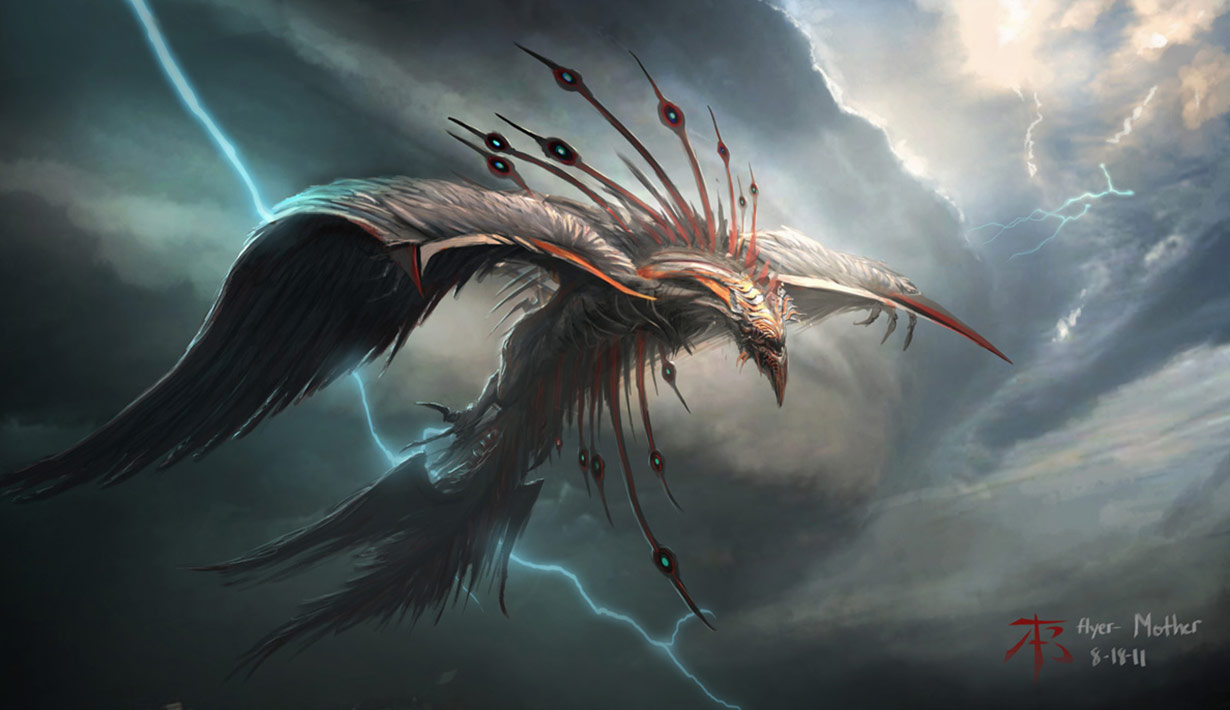The Lykha
The Lykha is a monstrous predator that predates even the oldest known civilizations of Sudraske. It calls all parts of the world its home and finds its occupants to be of little threat. The sight of these creatures brings with it a sense of immense wonder and fear. For seeing one of these creatures is to look at pure beauty and destruction.
Basic Information
Anatomy
The Lykha are gargantuan creatures. A full grown adult can dwarf a frigate class airship and effortlessly outpace them. Beyond this, very little is known about the Lykha's biological and morphological characteristics and attributes as there are no ancient fossils or fresh corpses to be studied. The other contributing factor to the lack of information is that no two Lykha are exactly alike. Many a scholar has attempted to categorize and log all known Lykha but their unique regenerative birthing process can quickly change any current records.
There are a few major characteristics that all Lykha have. They are all winged creatures that are able to fly and usually take on physical appearance and traits of predatory birds, bats and have been recorded to occasionally resemble dragons. The second defining characteristic is the influence Vir has on their physical form giving them a very notable elemental traits. The most reasonable comparison is to the mythical Phoenix creature and many scholar believes this to be one of the parent species of this creature.
Refer to the current dosier "Documented Lykha as of 322 P.E." for a record of all Lykha in the "Occupied Sphere".
Genetics and Reproduction
Current records outline that the Lykha is an asexual creature. Upon death, both natural or otherwise, the corpse of the Lykha will decompose at an alarming rate and reform into a set of three eggs. A portion of the corpse will form into root like structures that stretch out, in some cases, up to several miles. The shell of the egg has so far been impervious to any available technology meaning that removing the current threat of a Lykha will only bring back a future unknown threat.
When the first egg has hatched, the new born Lykha will consume the two other eggs eating the contents within and absorbing their . In the rare case that two Lykha hatch at the same time, a gruesome and destructive battle transpires until one kills and consumes the other.
Growth Rate & Stages
The Lykha has three main stages: Incubation, Intake and Mature. Scholars occasionally use a fourth stage, for age classification however there is no notable physical difference that has been discovered.
The Incubation Stage is from the time of death through the forming of the eggs and eventual hatching of the new Lykha. Records currently outline that the average duration for this stage is 28 "Lunar Cycles".
The Intake Stage is from the moment of hatching through the destruction and final consumption of the other eggs and in some cases kin. Many Cities have been devastated and in some cases destroyed due to the chaotic and brutal battles that occur when a pod (three newly hatched Lykha) battle to the death.
The Mature Stage is used to define a Lykha that has successfully consumed it's kin and begun to roam, hunt and claim it's own territory.
The Adult Stage is a rare classification used to note particular Lykha that exceed 100 "Solis Cycles".
Ecology and Habitats
Due to it's unique reproductive process, the Lykha has been able to dominate any environment it is born into. Once born, it has been observed that they will avoid their elemental opposite. For example, "Ignis-Vir" impregnated Lykha will take care to avoid "Aqua-Vir" concentrations.
Dietary Needs and Habits
The Lykha is a carnivourous creature that has not been observed to have a particular taste for any one food source. They are natural hunters and have been known to both silently stock a single target as well as terrorize and devour large herds of animals.
A scholar by the name of “_____” recently submitted a research paper, Vir and the Eating Habits of Sudraske’s Apex Predator. The paper outlines how Lykha may find nourishment from Vir sources that suggests their eating habits and the non cyclical nature of their feeding may have a deeper meaning. This research paper has been aggressively debated by several scholars claiming that the sample size and lack of external validity makes this and inadmissible study and that "_____" should be discredited. Despite the protests of numerable scholars, "The Sudraske University" granted “_____” significant funding for further research.
Biological Cycle
Most Lykha have been observed to have a form of seasonal changes tied to the local fluxuations of Vir in their territory. This change is most apparent in "Terra-Vir" infused Lykha as they frequently possess foliage in place of feathers and other woodland characteristics.
Additional Information
Perception and Sensory Capabilities
A topic of great debate among Sudraske's scholars as there are no cadavers available for detailed study. The most widely accepted theory is that the Lykha uses a hybrid form of Vir and echolocation which is colloquially referred to as "Vir Sight". Due to the wide variety of recorded species scholars believe there has to be a strong underlying biological framework that all Lykha possess.
Genetic Ancestor(s)
Scientific Name
Avian
Origin/Ancestry
Unknown origins
Lifespan
120 Solis Cycles
Conservation Status
No conservation efforts currently in place
Average Height
18m
Average Length
30m
Remove these ads. Join the Worldbuilders Guild









https://www.youtube.com/watch?v=zUi5xKQXG6I&ab_channel=happyHoolahopperTooler Have you considered how this video may impact how the audience will interpret things?
I have not...